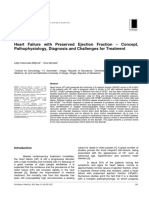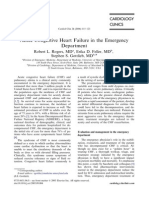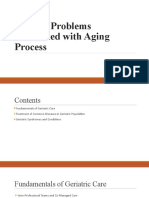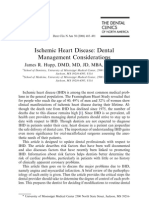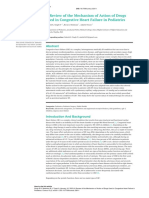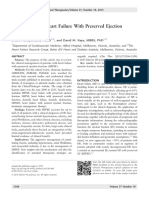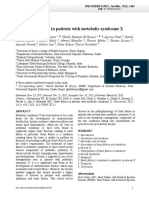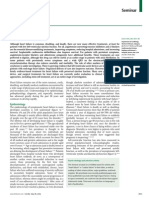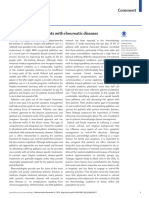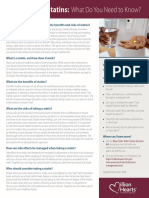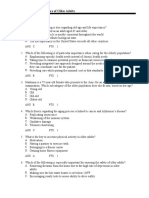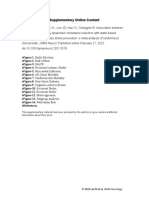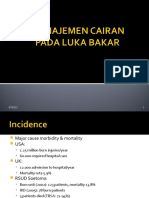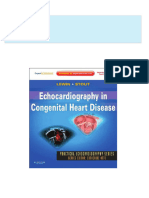HF in Elderly
HF in Elderly
Uploaded by
Hadi M.WCopyright:
Available Formats
HF in Elderly
HF in Elderly
Uploaded by
Hadi M.WOriginal Title
Copyright
Available Formats
Share this document
Did you find this document useful?
Is this content inappropriate?
Copyright:
Available Formats
HF in Elderly
HF in Elderly
Uploaded by
Hadi M.WCopyright:
Available Formats
Journal of Geriatric Cardiology (2016) 13: 115117
©2016 JGC All rights reserved; www.jgc301.com
Editorial
Open Access
Heart failure in the elderly
Pablo Díez-Villanueva, Fernando Alfonso*
Department of Cardiology, Hospital Universitario de la Princesa, Madrid, Spain
J Geriatr Cardiol 2016; 13: 115117. doi: 10.11909/j.issn.1671-5411.2016.02.009
Keywords: Elderly; Heart failure; Prognosis
Heart failure (HF) is a major public health problem risk of cardiovascular events and mortality during short and
worldwide entailing high morbidity and mortality as well as long term follow-up.[6,7] Elderly patients show a different
high costs.[1] This chronic syndrome associates with a low clinical profile when compared with younger patients. In
functional status and quality of life. Most patients with HF particular, elderly patients with HF often present with com-
are elderly, constituting up to 80% of patients suffering plex comorbidities (hypertension, atrial fibrillation, periph-
from this disease with both incidence and prevalence of the eral vascular disease and coronary artery disease, valvular
condition increasing with age.[2] This is due to the progres- disease and kidney failure or anemia) and polypharmacy.[6,7]
sive aging of the population as well as improved and better Moreover, some clinical features common in older popula-
survival after cardiac insults, such as myocardial infarction, tion may further complicate the course of the disease. Al-
especially in developed countries. Notably, acute HF is the though all these factors are well known to impact the prog-
leading cause of hospitalization in patients over 65 years. nosis of elderly patients with HF they are often overlooked
Accordingly, early diagnosis and proper treatment are criti- or simply not considered in the comprehensive diagnostic
cal as they both influence prognosis in these patients.[3] Ma- approach that is required in these patients. First, related to
jor therapeutic advancements, including drug development co-morbidities, particularly respiratory disease and obesity
and some technological improvements related to HF thera- should be carefully analyzed. On the other hand, elder pa-
pies, have occurred in the last decade.[4] However, there is tients often have a low functional status. This may compli-
concern about whether patients treated every day in our cate the interpretation of symptoms related to any effort as a
clinical practice are similar to those included in clinical tri- result of the low level of daily physical activity. In this re-
als where these therapeutic strategies clearly demonstrated gard, lower exercise performance and loss of body weight
clinical efficacy. This is especially so for elderly patients, involve higher risk and worse outcomes.[8–10] Importantly,
often under-represented or excluded in such large clinical physical activity has demonstrated a protective effect on HF
trials.[5] Of note, the term “elder” has been applied until re- risk.[11] Frailty (which means a decreased physiologic re-
cently to patients with more than 65 years of age. Neverthe- serve and resistance to stressors), also very common in eld-
less, given the aging population, the age group that includes erly patients with HF, is an independent predictor of adverse
“elderly patients” has shifted to over 70–80 years, with all outcomes.[12] Notably, frailty is associated with poorer
the implications that this change implies. These patients are prognosis in terms of quality of life, hospitalization and
even more underrepresented in large controlled clinical tri- mortality.[12–14] Finally, depression and anxiety, as well as
als. Therefore most experts consider further evidence is the often unrecognized cognitive impairment and dementia,
required, especially regarding issues related to specific are also frequently found in these patients and are related to
characteristics of the elderly population. In addition, the worse clinical outcomes.[15–17] Consequently, continuous
importance of proper diagnosis and adequate and optimized efforts should be made to readily detect and adequately di-
therapy, which also refers to treatment of comorbidities, agnose and treat these associated conditions. Eventually, the
should be highlighted. Likewise, issues regarding the clinical decision-making process required in these patients
end-of-life care ought to be addressed with major attention may be very challenging but is facilitated when a multidis-
in the subset of very old patients with HF. ciplinary approach is organized to address all these prob-
In patients with HF, age is associated with an increased lems.
A correct diagnosis requires the presence of symptoms
*Correspondence to: E-mails: falf@hotmail.com suggestive of HF, as well as a detailed echocardiographic
http://www.jgc301.com; jgc@jgc301.com | Journal of Geriatric Cardiology
116 Díez-Villanueva P & Alfonso F. HF in the elderly
assessment in order to confirm the diagnosis.[4] However, based on evidence discussions should consider the risk and
clinical characteristics, and specifically the other aspects benefits of any therapy in patients with HF. Importantly, pa-
previously discussed inherently related to elderly patients tients themselves should be involved in the clinical decision-
may complicate the diagnosis. Orthopnea and paroxysmal making process involved in their management throughout
nocturnal dyspnea constitute the most useful clinical symp- the entire course of the disease.[30–32] Eventually, in very eld-
toms.[18] Levels of natriuretic peptides may increase with erly patients with advanced HF, or reaching the end-of-life,
age and with some of the related comorbidities.[19] And the aim of the care is to achieve the maximum quality of life.[33]
normal values of these peptides may be used to precisely In conclusion, elderly patients with HF constitute the
exclude that symptoms are indeed due to HF.[4] Of relevance, majority of patients with HF, and their number is increasing.
natriuretic peptides have also demonstrated to be useful to However, they remain underrepresented in large clinical
guide medical HF therapy.[20] trials. The clinical profiles of these patients differ from those
Concerning therapy, some special issues should be taken of younger patients entailing a significantly worse prognosis.
into account. Elderly patients receive less frequently angio- Elderly patients often receive less specialized care. Conse-
tensin converting enzyme inhibitors, beta-blockers and spi- quently, it seems reasonable to provide a holistic approach,
ronolactone. This may represent a management bias in eld- including a multidisciplinary and comprehensive clinical
erly patients with HF. Potential explanations include that evaluation, to ensure adequate and proportionate care. Fi-
such patients often show greater comorbidity but also that nally, continuous efforts to advance in knowledge and to
they are less frequently referred to a cardiologist which, in better understand this challenging clinical entity are still
turn, may result in a lower adherence to current clinical necessary and to improve the care and the prognosis of eld-
guidelines.[21,22] Moreover, and despite some differences in erly patients with HF.
medication tolerance, drugs recommended for HF are fre-
quently underused in the elderly whereas optimal doses are References
frequently not achieved in these patients in spite of their
1 Roger VL, Go AS, Lloyd-Jones DM, et al. Heart disease and
positive impact on prognosis.[23,24] Consequently, elderly
stroke statistics–2012 update: a report from the American
patients with HF often do not benefit from an optimized
Heart Association. Circulation 2012; 125: e2–e220.
medical regimen.[25,26] It is also important to keep in mind 2 Go AS, Mozaffarian D, Roger VL, et al. Executive summary:
that a correct therapeutic approach includes the treatment of heart disease and stroke statistics–2013 update: a report
predisposing causes and precipitating factors.[3] Patients from the American Heart Association. Circulation 2013;127:
with worse baseline characteristics have less tolerance to 143–152.
therapeutic strategies with proven prognostic benefit.[10] It is, 3 van Riet EE, Hoes AW, Limburg A, et al. Prevalence of un-
therefore, essential to properly identify patients in whom an recognized heart failure in older persons with shortness of
optimized medical therapy may be implemented to further breath on exertion. Eur J Heart Fail 2014; 16: 772–777.
improve clinical outcome. 4 McMurray JJ, Adamopoulos S, Anker SD, et al. ESC Guide-
lines for the diagnosis and treatment of acute and chronic
Adherence to medical treatment is another relevant issue.
heart failure 2012: The Task Force for the Diagnosis and
In a recent review of the literature that included 17 studies
Treatment of Acute and Chronic Heart Failure 2012 of the
and more than 160,000 patients, older age was associated European Society of Cardiology. Developed in collaboration
with adequate adherence to medical therapy in patients with with the Heart Failure Association (HFA) of the ESC. Eur
HF.[27] In this regard, efforts in order to strength compliance Heart J 2012; 33: 1787–1847.
and improve results are essential, especially in elderly pa- 5 Cherubini A, Oristrell J, Pla X, et al. The persistent exclusion
tients with polypharmacy or cognitive problems.[27] Al- of older patients from ongoing clinical trials regarding heart
though clinical guidelines recommend against the use of failure. Arch Intern Med. 2011; 171: 550–556.
devices such as implantable cardioverter-defibrillators or 6 Metra M, Cotter G, El-Khorazaty J, et al. Acute heart failure
cardiac resynchronization therapy in patients with life ex- in the elderly: differences in clinical characteristics, outcomes,
and prognostic factors in the VERITAS Study. J Card Fail
pectancy < 1 year, the elderly or treatment-refractory pa-
2015; 21: 179–188.
tients may benefit from these advanced therapies.[4,28] Fi-
7 Metra M, Mentz RJ, Chiswell K, et al. Acute heart failure in
nally, it should be noted that, irrespective of age, disease elderly patients: worse outcomes and differential utility of
progress for individual patients with HF is difficult to an- standard prognostic variables. Insights from the PROTECT
ticipate, as there is no ‘typical’ dying trajectory.[29] Loss of trial. Eur J Heart Fail 2015; 17: 109–118.
functional capacity or autonomy may occur gradually or 8 Anker SD, Negassa A, Coats AJ, et al. Prognostic importance
abruptly and sudden death is a frequent event. Honest and of weight loss in chronic heart failure and the effect of treat-
Journal of Geriatric Cardiology | jgc@jgc301.com; http://www.jgc301.com
Díez-Villanueva P & Alfonso F. HF in the elderly 117
ment with angiotensin-converting-enzyme inhibitors: an ob- peptide-guided compared with standard medical therapy in
servational study. Lancet 2003; 361: 1077–1083. elderly patients with congestive heart failure: results from
9 Carubelli V, Metra M, Corrà U, et al. Exercise performance is TIME-CHF. Eur J Heart Fail 2013; 15: 910–918.
a prognostic indicator in elderly patients with chronic heart 21 Johansson S, Wallander MA, Ruigómez A, et al. Incidence of
failure–application of metabolic exercise cardiac kidney in- newly diagnosed heart failure in UK general practice. Eur J
dexes score. Circ J 2015; 79: 2608–2615. Heart Fail 2001; 3: 225–231.
10 Rossignol P, Masson S, Barlera S, et al. Loss in body weight 22 Rutten FH, Grobbee DE, Hoes AW. Differences between
is an independent prognostic factor for mortality in chronic general practitioners and cardiologists in diagnosis and man-
heart failure: insights from the GISSI-HF and Val-HeFT trials. agement of heart failure: a survey in every-day practice. Eur J
Eur J Heart Fail 2015; 17: 424–433. Heart Fail 2003; 5: 337–344.
11 Kraigher-Krainer E, Lyass A, Massaro JM, et al. Association 23 Komajda M, Hanon O, Hochadel M, et al. Contemporary
of physical activity and heart failure with preserved vs. re- management of octogenarians hospitalized for heart failure in
duced ejection fraction in the elderly: the Framingham Heart Europe: Euro Heart Failure Survey II. Eur Heart J 2009; 30:
Study. Eur J Heart Fail 2013; 15: 742–746. 478–486.
12 Uchmanowicz I, Gobbens RJ. The relationship between frailty, 24 Barywani SB, Ergatoudes C, Schaufelberger M, et al. Does
anxiety and depression, and health-related quality of life in the target dose of neurohormonal blockade matter for outcome
elderly patients with heart failure. Clin Interv Aging 2015; 10: in Systolic heart failure in octogenarians? Int J Cardiol 2015;
1595–1600. 187: 666–672.
13 Lien CT, Gillespie ND, Struthers AD, et al. Heart failure in frail 25 Pulignano G, Del Sindaco D, Tavazzi L, et al. Clinical fea-
elderly patients: diagnostic difficulties, co-morbidities, polyphar- tures and outcomes of elderly outpatients with heart failure
macy and treatment dilemmas. Eur J Heart Fail 2002; 4: 91–98. followed up in hospital cardiology units: data from a large na-
14 Cacciatore F, Abete P, Mazzella F, et al. Frailty predicts long- tionwide cardiology database (IN-CHF Registry). Am Heart
term mortality in elderly subjects with chronic heart failure. J 2002; 143: 45–55.
Eur J Clin Invest 2005; 35: 723–730. 26 Yancy CW, Fonarow GC, Albert NM, et al. Influence of pa-
15 Moser DK, Dracup K, Evangelista LS, et al. Comparison of tient age and sex on delivery of guideline-recommended heart
prevalence of symptoms of depression, anxiety, and hostility failure care in the outpatient cardiology practice setting: find-
in elderly patients with heart failure, myocardial infarction, ings from IMPROVE HF. Am Heart J 2009; 157: 754–762.
and a coronary artery bypass graft. Heart Lung 2010; 39: 27 Krueger K, Botermann L, Schorr SG, et al. Age-related
378–385. medication adherence in patients with chronic heart failure:
16 Huijts M, van Oostenbrugge RJ, Duits A, et al. Cognitive a systematic literature review. Int J Cardiol 2015; 184:
impairment in heart failure: results from the Trial of Intensi- 728–735.
fied versus standard Medical therapy in Elderly patients with 28 Olechowski B, Sands R, Zachariah D, et al. Is cardiac resyn-
Congestive Heart Failure (TIME-CHF) randomized trial. Eur chronisation therapy feasible, safe and beneficial in the very
J Heart Fail 2013; 15: 699–707. elderly? J Geriatr Cardiol 2015; 12: 497–501.
17 Cermakova P, Lund LH, Fereshtehnejad SM, et al. Heart 29 Gott M, Barnes S, Parker C, et al. Dying trajectories in heart
failure and dementia: survival in relation to types of heart fai- failure. Palliat Med 2007; 21: 95–99.
lure and different dementia disorders. Eur J Heart Fail 2015; 30 Jaarsma T, Beattie JM, Ryder M, et al. Palliative care in heart
17: 612–619. failure: a position statement from the palliative care workshop
18 Manzano L, Escobar C, Cleland JG, et al. Diagnosis of eld- of the Heart Failure Association of the European Society of
erly patients with heart failure. Eur J Heart Fail 2012; 14: Cardiology. Eur J Heart Fail 2009; 11: 433–443.
1097–1103. 31 McClung JA. End-of-life care in the treatment of advanced
19 Luchner A, Behrens G, Stritzke J, et al. Long-term pattern of heart failure in the elderly. Cardiol Rev 2013; 21: 9–15.
brain natriuretic peptide and N-terminal pro brain natriuretic 32 Datino T, Rexach L, Vidán MT, et al. Guidelines on the
peptide and its determinants in the general population: contri- management of implantable cardioverter defibrillators at the
bution of age, gender, and cardiac and extra-cardiac factors. end of life. Rev Esp Geriatr Gerontol 2014; 49: 29–34.
Eur J Heart Fail 2013; 15: 859–867. 33 Kraai IH, Vermeulen KM, Luttik ML, et al. Preferences of
20 Sanders-van Wijk S, Muzzarelli S, Neuhaus M, et al. Safety heart failure patients in daily clinical practice: quality of life or
and tolerability of intensified, N-terminal pro brain natriuretic longevity? Eur J Heart Fail 2013; 15: 1113–1121.
http://www.jgc301.com; jgc@mail.sciencep.com | Journal of Geriatric Cardiology
You might also like
- ESRD Case Analysis - Group 4Document34 pagesESRD Case Analysis - Group 4Sean Jeffrey J. FentressNo ratings yet
- Refeeding Syndrome Current Opinion 2020Document5 pagesRefeeding Syndrome Current Opinion 2020Pedro Paulo GuerraNo ratings yet
- Management of Heart Failure in Older PeopleDocument8 pagesManagement of Heart Failure in Older PeopleimorenolNo ratings yet
- Gheorghiu V Et Al 2017Document9 pagesGheorghiu V Et Al 2017Margarida ReisNo ratings yet
- ADHF ManagementDocument6 pagesADHF ManagementEsti YunitaNo ratings yet
- End of Life Care in Heart Failure: A Framework For ImplementationDocument28 pagesEnd of Life Care in Heart Failure: A Framework For ImplementationGaganNo ratings yet
- Vulnerable Period in Heart Failure. A Window of Opportunity For The Optimization of Treatmentt. A Statement by Mexican ExpertsDocument18 pagesVulnerable Period in Heart Failure. A Window of Opportunity For The Optimization of Treatmentt. A Statement by Mexican Expertsluis sanchezNo ratings yet
- Heart Failure With Preserved Ejection Fraction - Concept, Pathophysiology, Diagnosis and Challenges For TreatmentDocument7 pagesHeart Failure With Preserved Ejection Fraction - Concept, Pathophysiology, Diagnosis and Challenges For TreatmentOngky AristianNo ratings yet
- 2020 Heart Failure, Older People and FrailtyDocument21 pages2020 Heart Failure, Older People and Frailtyalejandromfunes1749No ratings yet
- 101307-435287-3-PBDocument9 pages101307-435287-3-PBwamapo2853No ratings yet
- Continuing Cardiology EducationDocument7 pagesContinuing Cardiology EducationAnonymous NeRC5JYiSNo ratings yet
- Medical Optimization of The Peripheral Artery Disease PatientDocument11 pagesMedical Optimization of The Peripheral Artery Disease Patientafso afsoNo ratings yet
- Adhrence 1Document9 pagesAdhrence 1nabilahbilqisNo ratings yet
- Evaluation and Management of Perioperative HypertensionDocument126 pagesEvaluation and Management of Perioperative HypertensionjoelruizmaNo ratings yet
- Insuficiencia Cardiaca Terminal 2023Document10 pagesInsuficiencia Cardiaca Terminal 2023Daniel GonzálezNo ratings yet
- Congestive Heart Failure in The ElderlyDocument13 pagesCongestive Heart Failure in The ElderlyKezia MarsilinaNo ratings yet
- Acute Congestive Heart Failure in The Emergency DepartmentDocument9 pagesAcute Congestive Heart Failure in The Emergency DepartmentAlanNo ratings yet
- JurdingDocument7 pagesJurdingsiti hazard aldinaNo ratings yet
- 1 - Pobrotyn P - Evaluation of Frailty Syndrome and Adherence To Recommendations in Elderly Patients WithDocument11 pages1 - Pobrotyn P - Evaluation of Frailty Syndrome and Adherence To Recommendations in Elderly Patients WithKhairunnisa Ayu KresnandaNo ratings yet
- Long-Term Dietary Adherence and Changes in Dietary Intake in Coronary Patients After Intervention With A Mediterranean Diet or A Low-Fat Diet The CORDIOPREV Randomized TrialDocument12 pagesLong-Term Dietary Adherence and Changes in Dietary Intake in Coronary Patients After Intervention With A Mediterranean Diet or A Low-Fat Diet The CORDIOPREV Randomized Trialzainab asalNo ratings yet
- Comment: Vs 140 (61 4%) of 228 Patients Hazard Ratio (HR)Document2 pagesComment: Vs 140 (61 4%) of 228 Patients Hazard Ratio (HR)Barbara Sakura RiawanNo ratings yet
- A Look Back at "The Management of Heart Failure 5 Years Hence"Document3 pagesA Look Back at "The Management of Heart Failure 5 Years Hence"Herman HermansyahNo ratings yet
- Myocardial Revascularization in Heart Failure A State-Of-The-Art ReviewDocument13 pagesMyocardial Revascularization in Heart Failure A State-Of-The-Art ReviewF02 Asyifa WidyaNo ratings yet
- Living With and Dying From Advanced Heart Failure - Understanding The Needs of Older Patients at The End of LifeDocument11 pagesLiving With and Dying From Advanced Heart Failure - Understanding The Needs of Older Patients at The End of LifeimorenolNo ratings yet
- Jurnal 5Document6 pagesJurnal 5Siti rahmi AbukhaerNo ratings yet
- PAD Current InsightsDocument15 pagesPAD Current InsightsMaria PopNo ratings yet
- Clinical Problems Associated With Aging ProcessDocument28 pagesClinical Problems Associated With Aging Processهنادي رازمNo ratings yet
- 2016 Home Inotropes and Other Palliative CareDocument12 pages2016 Home Inotropes and Other Palliative CareucincmnsigloxxiNo ratings yet
- Dent Clin N Am 50 (2006) 483-491Document9 pagesDent Clin N Am 50 (2006) 483-491lalajanNo ratings yet
- Causes of Heart FailureDocument4 pagesCauses of Heart Failurejana7-7No ratings yet
- A Review of The Mechanism of Action of Drugs Used in Congestive Heart Failure in PediatricsDocument9 pagesA Review of The Mechanism of Action of Drugs Used in Congestive Heart Failure in PediatricsFernando CardiologíaNo ratings yet
- HTA y EjercicioDocument8 pagesHTA y EjercicioCatalinaNo ratings yet
- Nova College of Pharmaceutical Education and Research InstituteDocument10 pagesNova College of Pharmaceutical Education and Research Instituteuradi sarithaNo ratings yet
- Effect of Age On Mortality, Hospitalizations and Response To Digoxin in Patients With Heart Failure: The DIG StudyDocument10 pagesEffect of Age On Mortality, Hospitalizations and Response To Digoxin in Patients With Heart Failure: The DIG StudyShakrie AbdullahNo ratings yet
- Management of Heart Failure With Preserved EjectionFraction A Review PDFDocument13 pagesManagement of Heart Failure With Preserved EjectionFraction A Review PDFGharbi StrongNo ratings yet
- Polytrauma in The Elderly: Specific Considerations and Current Concepts of ManagementDocument10 pagesPolytrauma in The Elderly: Specific Considerations and Current Concepts of ManagementUdien Jmc Tíga TìgaNo ratings yet
- Chronic Heart Failure-Part IDocument18 pagesChronic Heart Failure-Part IdrtpkNo ratings yet
- Interdisciplinary Assessment and Diagnostic Algo - 2021 - Diabetes Research And1Document3 pagesInterdisciplinary Assessment and Diagnostic Algo - 2021 - Diabetes Research And1probo asmoroNo ratings yet
- Cardiogeriatrics The Current State of The Art 2024Document7 pagesCardiogeriatrics The Current State of The Art 2024Jennifer BarretoNo ratings yet
- CardiomyopathyDocument3 pagesCardiomyopathyCzarinaNo ratings yet
- Geriatric Renal Paliative Care 2012Document10 pagesGeriatric Renal Paliative Care 2012Marcela De La PazNo ratings yet
- Ac HF1Document3 pagesAc HF1Kocsis IldikoNo ratings yet
- JGC 15 07 504 PDFDocument9 pagesJGC 15 07 504 PDFZuhalJanuarNo ratings yet
- J of Clinical Hypertension - 2019 - Turana - High Blood Pressure in Dementia How Low Can We GoDocument8 pagesJ of Clinical Hypertension - 2019 - Turana - High Blood Pressure in Dementia How Low Can We GoyudaNo ratings yet
- CareofolderadultsDocument8 pagesCareofolderadultsMonique FranciscoNo ratings yet
- Heart Failure in Patients With Metabolic Syndrome XDocument12 pagesHeart Failure in Patients With Metabolic Syndrome XErwin SiahaanNo ratings yet
- Cardiac Self-Efficacy and Quality of Life in Patients With Coronary Heart Disease: A Cross-Sectional Study From PalestineDocument13 pagesCardiac Self-Efficacy and Quality of Life in Patients With Coronary Heart Disease: A Cross-Sectional Study From Palestineشبلي غرايبهNo ratings yet
- Patient Assessment HandoutDocument17 pagesPatient Assessment HandoutHisyam IshakNo ratings yet
- Seminar: John J V Mcmurray, Marc A PfefferDocument13 pagesSeminar: John J V Mcmurray, Marc A Pfefferjvasco_santos8178No ratings yet
- Factors Associated With Depression and Anxiety of Hospitalized Patients With Heart FailureDocument10 pagesFactors Associated With Depression and Anxiety of Hospitalized Patients With Heart FailureineNo ratings yet
- Jurnal Kardio3Document8 pagesJurnal Kardio3Andi SusiloNo ratings yet
- Guideline ADHFDocument20 pagesGuideline ADHFBritneyNo ratings yet
- Oral Heart Failure Medications: An Update For Home Health CliniciansDocument12 pagesOral Heart Failure Medications: An Update For Home Health CliniciansSaraTravassosNo ratings yet
- Chronic Kidney Disease Transcript Group 4Document7 pagesChronic Kidney Disease Transcript Group 4MiardoNo ratings yet
- Modern methods for methods for lv dysfunctionDocument70 pagesModern methods for methods for lv dysfunctionK BhaskarNo ratings yet
- Estimation of Cardiovascular DiseaseDocument14 pagesEstimation of Cardiovascular DiseaseShree Narayan YadavNo ratings yet
- Reuma y Cuidados PaliativosDocument2 pagesReuma y Cuidados PaliativosMoisés LópezNo ratings yet
- Se Deberia Llamar Falla AgudaDocument10 pagesSe Deberia Llamar Falla Agudacrisuro35csrNo ratings yet
- Navigating Acute Heart Failure: Comprehensive Insights and Holistic ApproachesFrom EverandNavigating Acute Heart Failure: Comprehensive Insights and Holistic ApproachesNo ratings yet
- Antianginal. Hypolipidemic DrugsDocument13 pagesAntianginal. Hypolipidemic DrugsMadeline WanhartNo ratings yet
- Tesis PLT-WBC RatioDocument4 pagesTesis PLT-WBC RatioDanielMahendraNo ratings yet
- PAR Q FormDocument3 pagesPAR Q FormJaira Mier GalloNo ratings yet
- Rossi2021 It enDocument18 pagesRossi2021 It enNur Qalbi RamadhaniNo ratings yet
- Pediatric Advanced Life Support: Jan Bazner-Chandler CPNP, CNS, MSN, RNDocument65 pagesPediatric Advanced Life Support: Jan Bazner-Chandler CPNP, CNS, MSN, RNد. محمد فريد الغنامNo ratings yet
- Scoop On Statins-508Document1 pageScoop On Statins-508tommy taylor084No ratings yet
- ACES24Document6 pagesACES24Dr. Sarthak MishraNo ratings yet
- CCMSA Form 3Document88 pagesCCMSA Form 3cnonsowonNo ratings yet
- Nursing Care PlanDocument14 pagesNursing Care Plananimesh panda100% (3)
- Mitral Stenosis: Dr. Mohammed Asrafur Rahman MBBS, Bcs (H), MD Resident (Internal Medicine) (P-A) Chattogram Medical CollegeDocument16 pagesMitral Stenosis: Dr. Mohammed Asrafur Rahman MBBS, Bcs (H), MD Resident (Internal Medicine) (P-A) Chattogram Medical CollegeAsrafur RahmanNo ratings yet
- CADword - Mam Jelu NogoyDocument15 pagesCADword - Mam Jelu Nogoyhan_angelaNo ratings yet
- Unit 3Document44 pagesUnit 3ANANDHU PILLAINo ratings yet
- LINNC Trials Book 2023Document136 pagesLINNC Trials Book 2023José Ricardo CavalcantiNo ratings yet
- Electrocardiogram (Ecg or Ekg) : - 2 Components of ELECTRODESDocument4 pagesElectrocardiogram (Ecg or Ekg) : - 2 Components of ELECTRODESDhanNie CenitaNo ratings yet
- Antianginal Drugs Lecture NotesDocument10 pagesAntianginal Drugs Lecture NotesPrincewill SeiyefaNo ratings yet
- Chapter 77. Primary Care of Older AdultsDocument3 pagesChapter 77. Primary Care of Older AdultsAliNo ratings yet
- Indhu KamireddyDocument36 pagesIndhu KamireddyhepsiNo ratings yet
- Data Pasien Pulpak Dan Rujuk 2018Document8 pagesData Pasien Pulpak Dan Rujuk 2018zaluNo ratings yet
- Acls New JerseyDocument2 pagesAcls New JerseywilberespinosarnNo ratings yet
- Ncm101rle - Midterm ReviewerDocument15 pagesNcm101rle - Midterm RevieweraragonjonathanryanabcomNo ratings yet
- Decision making in health and medicine integrating evidence and values Second Edition, Reprinted Edition Hunink All Chapters Instant DownloadDocument62 pagesDecision making in health and medicine integrating evidence and values Second Edition, Reprinted Edition Hunink All Chapters Instant Downloadissamesssc100% (1)
- Jama Statin and Stroke Prevention SupplementDocument17 pagesJama Statin and Stroke Prevention SupplementMesan KoNo ratings yet
- HNHN (Nninõm HN'MK FPW H.) N. ZNHK FPW: To PMDocument1 pageHNHN (Nninõm HN'MK FPW H.) N. ZNHK FPW: To PMSuthan JoshuaNo ratings yet
- Manajemen Cairan Pada Luka BakarDocument38 pagesManajemen Cairan Pada Luka Bakarwati suwartaNo ratings yet
- Full download Echocardiography in Congenital Heart Disease 1st Edition Mark B. Lewin pdf docxDocument71 pagesFull download Echocardiography in Congenital Heart Disease 1st Edition Mark B. Lewin pdf docxshanyajagyNo ratings yet
- Dialog Bahasa InggrisDocument4 pagesDialog Bahasa InggrisestaaNo ratings yet
- Abdominal Examination: Before Examining The PatientDocument4 pagesAbdominal Examination: Before Examining The PatientrebeccaNo ratings yet
- GLPTI Course WorkbookDocument11 pagesGLPTI Course Workbooksohan828300No ratings yet
- Ketentuan Kodefikasi Pneumonia Kasus Rawat Inap Pada Pasien Jaminan Kesehatan Nasional (JKN) Berdasarkan ICD 10Document8 pagesKetentuan Kodefikasi Pneumonia Kasus Rawat Inap Pada Pasien Jaminan Kesehatan Nasional (JKN) Berdasarkan ICD 10Zulkarnain PrakosoNo ratings yet
- Cardiology Board Review - ECG, Hemodynamic and Angiographic Unknowns (Aug 5, 2019) - (1119423236) - (Wiley-Blackwell) 1st Edition George A. StoufferDocument59 pagesCardiology Board Review - ECG, Hemodynamic and Angiographic Unknowns (Aug 5, 2019) - (1119423236) - (Wiley-Blackwell) 1st Edition George A. Stouffermeawwezze100% (8)







